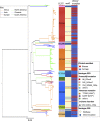Global Distribution of Invasive Serotype 35D Streptococcus pneumoniae Isolates following Introduction of 13-Valent Pneumococcal Conjugate Vaccine
- PMID: 29720431
- PMCID: PMC6018339
- DOI: 10.1128/JCM.00228-18
Global Distribution of Invasive Serotype 35D Streptococcus pneumoniae Isolates following Introduction of 13-Valent Pneumococcal Conjugate Vaccine
Abstract
A newly recognized pneumococcal serotype, 35D, which differs from the 35B polysaccharide in structure and serology by not binding to factor serum 35a, was recently reported. The genetic basis for this distinctive serology is due to the presence of an inactivating mutation in wciG, which encodes an O-acetyltransferase responsible for O-acetylation of a galactofuranose. Here, we assessed the genomic data of a worldwide pneumococcal collection to identify serotype 35D isolates and understand their geographical distribution, genetic background, and invasiveness potential. Of 21,980 pneumococcal isolates, 444 were originally typed as serotype 35B by PneumoCaT. Analysis of the wciG gene revealed 23 isolates from carriage (n = 4) and disease (n = 19) with partial or complete loss-of-function mutations, including mutations resulting in premature stop codons (n = 22) and an in-frame mutation (n = 1). These were selected for further analysis. The putative 35D isolates were geographically widespread, and 65.2% (15/23) of them was recovered after the introduction of pneumococcal conjugate vaccine 13 (PCV13). Compared with serotype 35B isolates, putative serotype 35D isolates have higher invasive disease potentials based on odds ratios (OR) (11.58; 95% confidence interval[CI], 1.42 to 94.19 versus 0.61; 95% CI, 0.40 to 0.92) and a higher prevalence of macrolide resistance mediated by mefA (26.1% versus 7.6%; P = 0.009). Using the Quellung reaction, 50% (10/20) of viable isolates were identified as serotype 35D, 25% (5/20) as serotype 35B, and 25% (5/20) as a mixture of 35B/35D. The discrepancy between phenotype and genotype requires further investigation. These findings illustrated a global distribution of an invasive serotype, 35D, among young children post-PCV13 introduction and underlined the invasive potential conferred by the loss of O-acetylation in the pneumococcal capsule.
Keywords: 35D; PCV; novel serotype; whole-genome sequencing.
Copyright © 2018 Lo et al.
Figures

References
-
- Wahl B, O'Brien KL, Greenbaum A, Liu L, Chu Y, Black R, Majumder A, Lukšić I, Nair H, McAllister D, Campbell H, Rudan I, Knoll M. 2016. Global burden of Streptococcus pneumoniae in children younger than 5 years in the pneumococcal conjugate vaccines (PCV) era: 2000–2015. International Symposium on Pneumococci and Pneumococcal Diseases, Glasgow, Scotland.
-
- Mostowy RJ, Croucher NJ, De Maio N, Chewapreecha C, Salter SJ, Turner P, Aanensen DM, Bentley SD, Didelot X, Fraser C. 2017. Pneumococcal capsule synthesis locus cps as evolutionary hotspot with potential to generate novel serotypes by recombination. Mol Biol Evol 34:2537–2554. doi:10.1093/molbev/msx173. - DOI - PMC - PubMed
Publication types
MeSH terms
Substances
LinkOut - more resources
Full Text Sources
Other Literature Sources
Medical

